Cancer – Skin Cancer – Squamous Cell Carcinoma
[ad name=”Tweet”]
Dear Your Own Vet,
I found a pink lump the size of a small marble on my dog’s stomach. It bleeds sometimes when he scratches it. Should I be worried about it and should I have it removed? He generally has bad skin and a lot of allergies and scabs on his belly from all the scratching. I use a cortisone cream that helps to control the redness and scabs but this lump hasn’t disappeared.
Thanks,
Clare
Florida, USA
Dear Clare,
What you are describing sounds like a skin cancer growing on your dog’s belly. Lumps that bleed and heal up are often cancerous and should rather be removed, to be on the safe side. The most common cancer caused by long term exposure to the sun is called Squamous Cell Carcinoma.
SQUAMOUS CELL CARCINOMA (SCC -The most common Skin Cancer)
This type of cancer is caused by long term exposure to high levels of ultraviolet rays in sunshine, thus it’s really only a problem in hotter parts of the world. It typically begins as a small red mark or blotch on the skin and can stay that way for years, and then suddenly enlarge and start to bleed. These cancers don’t usually spread or metastasize internally, but tend to be a problem that recurs over and over again after being cut out. Most dogs don’t just develop one – they may have hundreds of small cancers on their bellies, ans within a few months of one being cut out, there is another nasty one in it’s place. Unfortunately the operation to remove them can be expensive and extensive and often after one operation every year for three to four years in a row, owners elect to call it a day and put their pet to sleep.Some white dogs even get them on the eyelids and inside the eyes.
Squamous cell carcinomas in cats are found on the ears and nose, and literally “eat” the nose and ears away. They also start as a small innocuous looking scab that most owners assume is from a fight, or that the cat scratched itself, but the scab doesn’t heal up and suddenly blossoms into a nasty red sore that eats away at the ears and nose and bleeds on and off, making the cat shake it’s head and sneeze a lot (if on the nose).
WHICH ANIMALS ARE PRONE TO GETTING SQUAMOUS CELL CARCINOMA?
Animals that have very little pigment in their skin and who live in hot climates tend to be the worst affected. Terriers with short hair, such as the white Bull Terrier, Fox Terrier, American Pit Bull, Staffordshire Bull Terrier, White Boxer dogs and Jack Russell Terriers are very prone, as well as pure white cats, and cats with pink noses and white ear tips. Terriers often suffer with extensive allergies as well, so owners are used them scabs and scratching, so tend to ignore the problem for longer, assuming it is allergic again. Ironically, the sun plays a role, both in the bad allergies and skin infections that Bull Terriers are prone to, as well as in the development of cancer.
For this reason, white Boxer dogs are not to be bred or sold in many countries and are supposed to be euthanazed at birth. if you live in a hot climate and are considering getting any one of those breeds listed above, please do yourself and your pet a favor and get a dog that is not pure white, with slightly longer fur.
HOW CAN I PREVENT MY PET GETTING SKIN CANCER?
SUNSCREEN
It’s simple – as with children, regular application of sunscreen to an outdoor pet is essential. Although some owners complain the dogs simply lick the lotion off, there are many spray on, non lotion varieties for pets available on the market, such as “Petscreen.”
You can also use a human sunscreen intended for children. You should make sure that the sunscreen is over factor 15, and preferably over factor 30. If someone is at home during the day with your pet, it should be applied first thing in the morning, and then again at midday.
KEEP THEM OUT OF THE SUN
Keep your pet out of the sun!!! You would never allow your toddler to sunbathe for hours- but that’s just what these dogs and cats love to do! Dogs lie “tanning” with their bellies up in the air and cats will find a sunny spot and fall asleep for hours.
Everyone knows that even the best sunscreen doesn’t stop every single ray of ultraviolet from getting through. My advice is to make them semi indoor pets from the start – keep them indoors between 10 and 4 every day and let them out the rest of the time.
SUN SUITS
Sun suits for dogs are available, but can be hard to come by depending on where you live in the world – made of Lycra, they cover the dog’s vulnerable areas and protect them like a swimsuit from the sun.
However, most owners who have tried them said their dogs did not tolerate the suits well. But they are a good option.
BE AWARE OF THE WINTER SUN
The winter sun is the main culprit – not the summer sun!! Animals tend to lie in the shade in summer due to the heat, but in winter they will actively seek out the sun and lie in it for hours. Don’t think that because the temperature is colder that the sun is not harming your pets!
BE VIGILANT
Don’t ignore a scab that won’t heal up on your pet’s belly, ears, eyes or nose. The sooner it is removed, the easier the healing after, the cheaper for you, and the lower the chances it will recur. These tumors need to removed with a piece of healthy looking skin round them, otherwise they grow back fast and aggressively.
If you feel along your pet’s belly and there are many hard scabby pieces, these could be either early cancers or “actinic change” – precancerous sores. Get these removed and keep your pet out of the sun completely if you see them.
TREATING SQUAMOUS CELL CARCINOMA
SURGERY
This is the most common way of treating these tumors, but not always the most effective. Success of surgery is largely dependent on the size of the tumor, i.e. how long it has been left unattended and where it is located on the animal.
For example, surgery is very successful in removing a single growth less than 3mm on diameter in the middle of the belly in a bitch, but far less successful in removing that same size tumor on the nose of a white cat. Taking a piece of skin large enough off around the tumor is essential to stop it growing back, and this is far more easily achieved on the belly of a dog than on a cat’s face or in the pink part of an eye.
NOSECTOMY
This is the surgical removal of the entire outside part of a cat’s nose, leaving the cat with a nose that looks like it belongs to a pig afterward. Not that popular with owners as they consider it quite drastic, it necessitates a stay in hospital for a few days to control the bleeding, but can save your cat’s life if done early enough. If the cancer has spread off the nose onto the face, this will not be effective.
EAR AMPUTATION
Performed far more often than Nosectomy, ear amputation saves the lives of cats with skin cancer on their ears.
Although they tend to resemble “Scottish Folds” afterward, it does not affect them physically at all, they need to only spend a short time in hospital and the recovery is good.
RADIATION
This is one of the best ways to treat this type of cancer. It makes the cancers shrink and in some cases resolve completely after a course of treatments. It is unfortunately not popular with owners, who in many cases don’t have a couple of thousand to spend on their pets. The thought of radiation also tends to put people off, but the side effects are not nearly as bad as conventional chemotherapy, as in most cases, the beam of radiation can be targeted over the small are of the animal’s body where the tumor is.
It is not as convenient as surgery, as any vet can perform surgery, but vets with access to radiation are few and far between. If you are interested in doing radiation on your pet, the best place to ask about it would be a university based veterinary hospital. As with surgery, the sooner the cancer is treated the better the outcome. If the cancer has already eaten away into your cat’s face, the chances of a full recovery are far less than if the lesion is a small pink scab on the tip of the cat’s nose. For this reason, if you are an owner that would like to do the best for your pet, it’s usually better to do the radiation treatments before the surgery, rather than after three to four failed surgical attempts. Radiation is usually the preferred option in cats due to the extensive nature of the growth on very small, delicate body parts.
COMBINING RADIATION WITH SURGERY
This works very well. Animals are first sent for radiation to shrink the tumor and then, once it has been shrunk down, it can be completely removed surgically.
CHEMOTHERAPY
This is also used in cats – a small seed of chemotherapy is injected directly into the nose. Again, the success rate is high if used in this way and the side effects are minimal. Not all vets have access to this type of chemotherapy and may refer owners to specialist facilities. This is usually more expensive than surgery. Conventional intravenous chemotherapy unfortunately doesn’t work as well with these types of cancers.
CRYOTHERAPY AND CAUTERIZING/THERMOCAUTERY
This is the most common technique used in people with skin cancer. Either freezing or burning the cancer out can work if the cancer is very small and shallow, and the correct techniques are used – for example a single freeze will not get rid of it – a few cycles of freezing and thawing are needed to eliminate any cancer cells. It has not been found to be as effective as in people and any of the other listed options generally work better.
ANTIBIOTICS AND CORTISONE
These are generally used in animals that have passed the point of surgery to keep them comfortable. These tumors can get infected which becomes very painful. Long acting antibiotics such as Cefovecin and long acting cortisone infections such as Depo Medrol can help to improve the quality of life over the short term until owners are ready to make a decision to put their pet to sleep. Depo cortisone injections are notorious for having many side effects, such as causing animals to develop Diabetes mellitis and should really be used in cases in which there is nothing else one can really do.
A short course of antibiotics prior to surgery will help if the tumor is infected prior to surgery to reduce post op infection, bleeding and reduce the incidence of animals pulling out all the sutures.
PHOTODYNAMIC THERAPY
A newer type of therapy involving a vitamin A synthetic retinoids injected into the animal. In a study, only pre cancerous change successfully resolved with this treatment in dogs. Cats did not respond. Combining this with thermocautery helped with superficial lesions in dogs only. (1)
PIROXICAM
This anti inflammatory painkilling drug has been noted to have some effect against SCC. Use at the recommended dosages and give with food as it can affect the stomach lining, causing ulcers.
DIAGNOSIS OF SQUAMOUS CELL CARCINOMA
A biopsy of the growth or part of it sent to a pathologist will give you a definitive diagnosis. The local lymph nodes should be checked and chest x rays done to see if the cancer has spread. Sun induced SCC doesn’t often spread, but it can, but SCC in other body parts can be very malignant and spread easily.
SQUAMOUS CELL CARCINOMA IN OTHER PARTS OF THE BODY
If these types of cancers are found in the mouth, tonsils or on the feet by the nail beds, unfortunately the prognosis can be poor and I would recommend referring these animals to specialists for treatment (especially with oral SCC) as extensive amputation may be needed to save your pet’s life.
Multicentric SCC in cats is not sun induced and is seen in hairy pigmented areas of the skin, often presenting as multiple crusty scabs that won’t heal up. They don’t respond to antibiotics, cortisone and variably to radiation. (1)
REFERENCES
1. http://maxshouse.com/squamous_cell_carcinoma.htm
2. http://donkang.wordpress.com/2010/01/26/tumors-in-dogs-neck-squamous-cell-carcinoma-cats-face-100122/
3. http://www.lbah.com/feline/scc.html
4. http://www.merckvetmanual.com/mvm/htm/bc/itgtu902.htm
5. http://www.kyronlabs.co.za/products/product.php?pid=85
6. http://www.123rf.com/photo_5448159_a-white-siamese-cat-sleeping-on-the-grass-in-the-sun.html
7. http://www.ncbi.nlm.nih.gov/pmc/articles/PMC2964666/

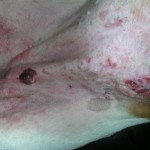
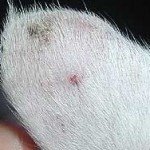




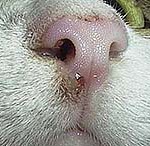
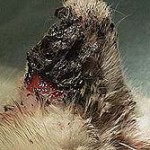


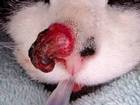
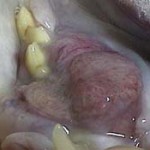
Leave a Reply
You must be logged in to post a comment.